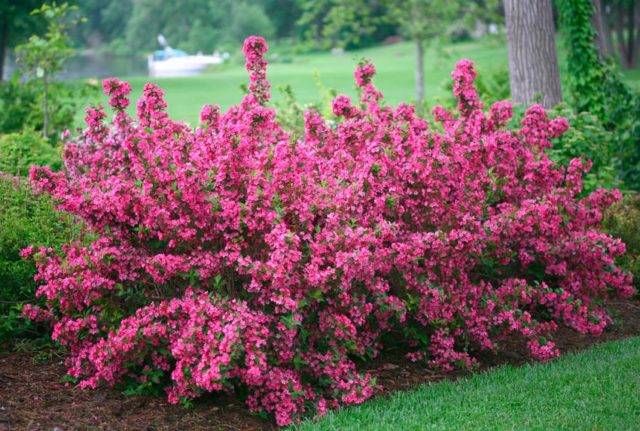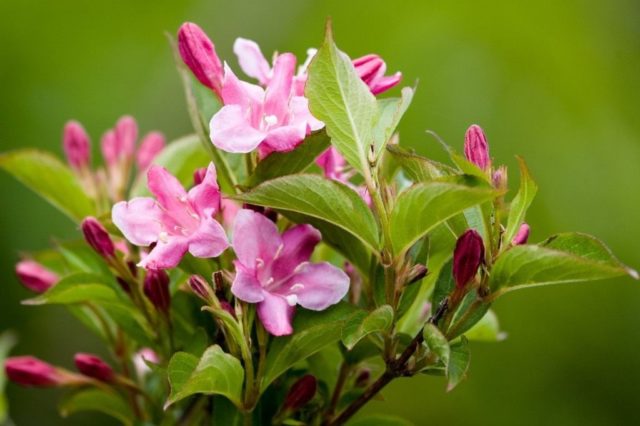Content
Weigela does not bloom, which means that the plant is in uncomfortable conditions. This ornamental shrub is characterized by abundant long flowering, therefore, when very few flowers bloom on the plant, or they do not appear at all, you need to try to find out why this is happening. In each case, the solution may be different, since there are several reasons for the lack of flowers in this plant.
When weigela blooms
There are many varieties of weigela that differ from each other in flowering time. The shrub blooms when the danger of frost has passed. On early varieties, buds appear in early May, and some varieties delight with flowering only in the second half of summer. In our country, several varieties are grown with the following flowering start dates:
- Weigela Middendorf - early May and September;
- early weigela - early May;
- blooming weigela - May-June;
- Weigela Nana Variegata - June-July;
- Weigela Nana Purpurea - May-June;
- weigela profusely - May.
The climate has a great influence on the quality of flowering of this culture: the light-loving drought-resistant shrub blooms the more abundantly and longer, the more warm, dry, sunny days in the season. In the conditions of a short cold summer, the flowering time of weigela can shift and shorten, and the autumn flowering may not come at all.
How long weigela blooms
Usually the shrub blooms for a long time, about 3-4 weeks, but there are varieties with a longer (up to a month) flowering. The peak of the decorative effect of the shrub is in the summer season.
Weigela, which blooms twice a season, is not uncommon, but in autumn it blooms less abundantly and lastingly than in spring. The second wave of flowering is possible only in some varieties under favorable weather conditions and good care.
Why weigela does not bloom and what to do
This plant is quite demanding on the growing conditions and violations of agricultural technology primarily affect flowering. With the elimination of negative factors, the flowering of the shrub is fully restored.
Violation of landing rules
Possible reasons for the lack of flowering of weigela may be associated with the following planting errors:
- a shaded place is chosen or a shrub is planted in a wind-blown area;
- the soil is prone to waterlogging, surface occurrence of groundwater;
- the soil is too dense and does not allow air to pass through;
- the soil is highly acidic, poor in mineral and organic matter;
- the wrong variety is selected.
Shrubs should be planted in open, unshaded areas, protected from cold winds. Some varieties can grow in diffused sunlight, for example, in the vicinity of large trees with a loose crown. However, in the shade of the weigela it develops poorly, flowering may be poor, occur at a later date, or it may be completely absent. In strong winds, a shrub may not bloom just because the air currents tear off delicate fragile buds. You can correct the situation by providing the shrub with sufficient lighting and protecting it from strong drafts.
The shrub feels well, which means it blooms profusely on light fertile soils. Stagnant water is detrimental to its root system, therefore, drainage is necessarily laid in the planting pit, and sometimes drainage systems are equipped.
A substrate that does not allow air to pass through can also cause the lack of flowers, therefore, when preparing the soil, it is well dug up and, if necessary, river sand is added. In the future, it is recommended to regularly loosen or mulch the trunk circles.
Poor soils are well fertilized before planting, applying organic and mineral fertilizers. Too acidic substrate is limed.
Weigela may not bloom due to an incorrectly selected variety, if the climate does not meet the needs of the plant.
Violation of the rules of care
The reasons why weigela may bloom poorly or not bloom at all may lie in errors in caring for a shrub. Most often, the problem occurs in the following cases:
- violation of watering rules;
- improper feeding;
- violation of the rules for pruning;
- irregular loosening or lack thereof.
Weigela is very sensitive to soil moisture. The plant may respond to prolonged stagnation of water at the roots by a deterioration of the growing season and a decrease in abundance, or even the termination of flowering. On the other hand, drying out of the soil harms flowering and vegetation no less than overflow. With a chronic lack of moisture, the plant will not have the strength to gain abundant buds.
The shrub needs fertilizing that stimulates the growth of green mass and the formation of buds. With a lack of minerals in the soil, flowering in weigela may also be absent.
Quite often, the lack of flowering is explained by the fact that inexperienced gardeners, in the process of annual pruning of the shrub, unknowingly remove the branches on which the buds are formed. If you prune in the fall and remove the shoots of the last year, you may never wait for the shrub to bloom, therefore weigela formative pruning is carried out only in spring.
Weigela is loosened deeply, on the bayonet of a shovel. If the shrub is not mulched, it is advisable to do this after each watering. Mulching reduces the amount of irrigation, enriches the soil with nutrients and prevents the formation of a dense layer around the bush. However, even in this case, loosening is necessary. Before the procedure, the mulch is removed and then returned to its place.
Pests or diseases
This ornamental shrub does not often get sick, but damage to plantings by pests or diseases can also be the reason why the plant does not bloom.
Aphids can cause great harm - they feed on bush juices, and their colonies can weaken the culture so much that flowering stops. Chlorophos can be used against the invasion of these pests, but folk remedies are also suitable: a solution of soap or alcohol, an aqueous extract of garlic or onions.
Spider mites, caterpillars and thrips also take away strength from the weigela. Pesticides work well with them; natural remedies such as water-infused wormwood, makhorka or hot pepper can be a less harmful alternative.
May beetle and bear harm to the roots, which not only negatively affects the flowering of the weigela, but can also have more serious consequences for the plant. The drug Aktara will help get rid of these pests.
Weigelu can be attacked by fungal and bacterial diseases, such as gray rot and rust. These ailments are treatable; treatment with a mixture of copper sulfate with milk of lime (Bordeaux liquid) will be required.
One of the most serious diseases of weigela is root cancer, which not only stops the flowering of the plant, but also leads to its death. Agronomists have not yet learned how to deal with it, so sick bushes are burned to prevent the spread of the disease.
Conclusion
Weigela does not bloom mainly because the technology of its cultivation is violated. With proper planting and quality care, this delicate shrub will delight the eye with long, abundant flowering for more than one year.










